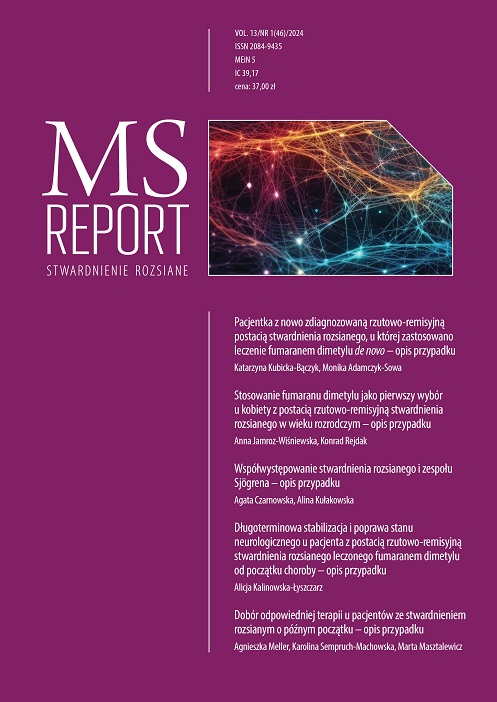Long-term effective therapy of multiple sclerosis with dimethyl fumarate in a patient with a pacemaker – case report Case report
Main Article Content
Abstract
The article describes a 46-year-old man who was diagnosed with the relapsing-remitting form of multiple sclerosis in 2011. The patient is with cardiological diseases. In 2015, he had a pacemaker implanted due to symptomatic second-degree atrioventricular block. In 2016, dimethyl fumarate was started as an immunomodulatory treatment due to intolerance or ineffectiveness of the previous treatments. In the dimethyl fumarate treatment period, there is no evidence of disease activity (NEDA 3). Due to the implanted pacemaker, magnetic resonance imaging requires the cooperation of a cardiologist during MRI examinations, which is possible in the multidisciplinary clinical site.
Article Details
Issue
Section
Articles
Copyright © by Medical Education. All rights reserved.
References
1. Polman CH, Reingold SC, Banwell B et al. Diagnostic criteria for multiple sclerosis: 2010 revisions to the McDonald criteria. Ann Neurol. 2011; 69(2): 292-302. http://doi.org/10.1002/ana.22366.
2. Giovannoni G, Tomic D, Bright JR et al. „No evident disease activity”: The use of combined assessments in the management of patients with multiple sclerosis. Mult Scler. 2017; 23(9): 1179-87. http://doi.org/10.1177/1352458517703193.
3. Sorensen PS, Sellebjerg F, Hartung HP et al The apparently milder course of multiple sclerosis: changes in the diagnostic criteria, therapy and natural history. Brain. 2020; 143(9): 2637-52. http://doi.org/10.1093/brain/awaa145.
4. Buron MD, Chalmer TA, Sellebjerg F et al. Comparative effectiveness of teriflunomide and dimethyl fumarate – A nationwide cohort study. Neurology. 2019; 92: 1-10. http://doi.org/10.1212/WNL.0000000000007314.
5. Braune S, Grimm S, van Hövell P et al.; NTD Study Group. Comparative effectiveness of delayed-release dimethyl fumarate versus interferon, glatiramer acetate, teriflunomide, or fingolimod: results from the German NeuroTransData registry. J Neurol. 2018; 265(12): 2980-92. http://doi.org/10.1007/s00415-018-9083-5.
6. Ontaneda D, Nicholas J, Carraro M et al. Comparative effectiveness of dimethyl fumarate versus fingolimod and teriflunomide among MS patients switching from first-generation platform therapies in the US. Mult Scler Relat Disord. 2019; 27: 101-11. http://doi.org/10.1016/j.msard.2018.09.038.
7. Prosperini L, Haggiag S, Ruggieri S et al. Dimethyl Fumarate or Teriflunomide for Relapsing-Remitting Multiple Sclerosis: A Meta-analysis of Post-marketing Studies. Neurotherapeutics. 2023; 20(5): 1275-83. http://doi.org/10.1007/s13311-023-01416-x.
8. Fox RJ, Chan A, Zhang A et al. Comparative effectiveness using a matching-adjusted indirect comparison between delayed-release dimethyl fumarate and fingolimod for the treatment of multiple sclerosis. Curr Med Res Opin. 2017; 33(2): 175-83. http://doi.org/10.1080/03007995.2016.1248380.
9. Lorscheider J, Benkert P, Lienert C et al. Comparative analysis of dimethyl fumarate and fingolimod in relapsing-remitting multiple sclerosis. J Neurol. 2021; 268(3): 941-9. http://doi.org/10.1007/s00415-020-10226-6.
10. Freedman MS, Devonshire V, Duquette P et al. Treatment Optimization in Multiple Sclerosis: Canadian MS Working Group Recommendations. Can J Neurol Sci. 2020; 47(4): 437-55. http://doi.org/10.1017/cjn.2020.66.
11. Saccà F, Lanzillo R, Signori A et al. Determinants of therapy switch in multiple sclerosis treatment-naïve patients: A real-life study. Mult Scler. 2019; 25(9): 1263-72. http://doi.org/10.1177/1352458518790390.
2. Giovannoni G, Tomic D, Bright JR et al. „No evident disease activity”: The use of combined assessments in the management of patients with multiple sclerosis. Mult Scler. 2017; 23(9): 1179-87. http://doi.org/10.1177/1352458517703193.
3. Sorensen PS, Sellebjerg F, Hartung HP et al The apparently milder course of multiple sclerosis: changes in the diagnostic criteria, therapy and natural history. Brain. 2020; 143(9): 2637-52. http://doi.org/10.1093/brain/awaa145.
4. Buron MD, Chalmer TA, Sellebjerg F et al. Comparative effectiveness of teriflunomide and dimethyl fumarate – A nationwide cohort study. Neurology. 2019; 92: 1-10. http://doi.org/10.1212/WNL.0000000000007314.
5. Braune S, Grimm S, van Hövell P et al.; NTD Study Group. Comparative effectiveness of delayed-release dimethyl fumarate versus interferon, glatiramer acetate, teriflunomide, or fingolimod: results from the German NeuroTransData registry. J Neurol. 2018; 265(12): 2980-92. http://doi.org/10.1007/s00415-018-9083-5.
6. Ontaneda D, Nicholas J, Carraro M et al. Comparative effectiveness of dimethyl fumarate versus fingolimod and teriflunomide among MS patients switching from first-generation platform therapies in the US. Mult Scler Relat Disord. 2019; 27: 101-11. http://doi.org/10.1016/j.msard.2018.09.038.
7. Prosperini L, Haggiag S, Ruggieri S et al. Dimethyl Fumarate or Teriflunomide for Relapsing-Remitting Multiple Sclerosis: A Meta-analysis of Post-marketing Studies. Neurotherapeutics. 2023; 20(5): 1275-83. http://doi.org/10.1007/s13311-023-01416-x.
8. Fox RJ, Chan A, Zhang A et al. Comparative effectiveness using a matching-adjusted indirect comparison between delayed-release dimethyl fumarate and fingolimod for the treatment of multiple sclerosis. Curr Med Res Opin. 2017; 33(2): 175-83. http://doi.org/10.1080/03007995.2016.1248380.
9. Lorscheider J, Benkert P, Lienert C et al. Comparative analysis of dimethyl fumarate and fingolimod in relapsing-remitting multiple sclerosis. J Neurol. 2021; 268(3): 941-9. http://doi.org/10.1007/s00415-020-10226-6.
10. Freedman MS, Devonshire V, Duquette P et al. Treatment Optimization in Multiple Sclerosis: Canadian MS Working Group Recommendations. Can J Neurol Sci. 2020; 47(4): 437-55. http://doi.org/10.1017/cjn.2020.66.
11. Saccà F, Lanzillo R, Signori A et al. Determinants of therapy switch in multiple sclerosis treatment-naïve patients: A real-life study. Mult Scler. 2019; 25(9): 1263-72. http://doi.org/10.1177/1352458518790390.

